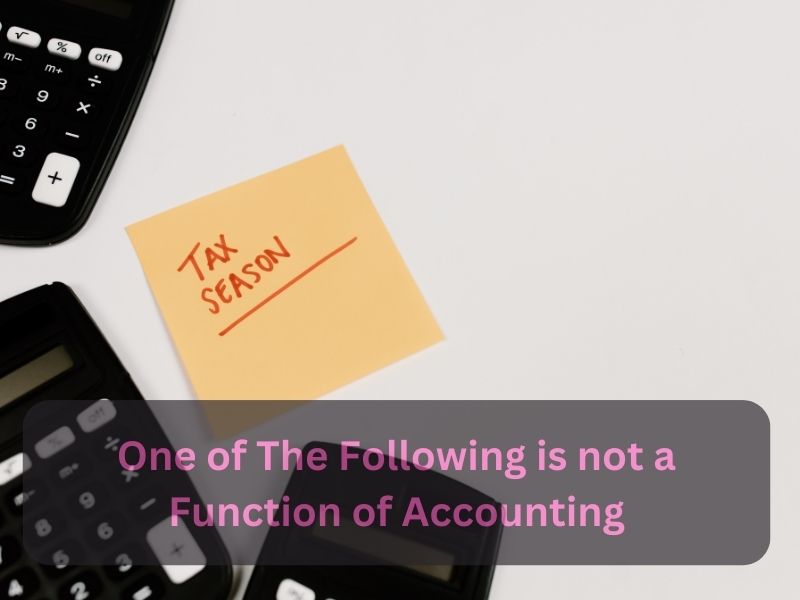Accounting is a system for providing quantitative information about economic entities that is intended to be useful in making economic decisions. It involves recording transactions, preparing financial statements and reporting them to outsiders. It also includes managerial accounting, cost accounting and tax accounting. This article will explore the functions of accounting and explain which one is not a function of accounting. Here, we will discuss about one of the following is not a function of accounting.
Accounts Payable
Accounts payable (AP) is a term for short-term debts that a business owes to its vendors or suppliers for goods and services that have been purchased on credit. This account is listed on the company’s balance sheet and a business’ general ledger, along with other liabilities like rents, utilities, licenses and outstanding vendor invoices.
A key function of accounts payable is the processing of incoming invoices and payments from vendors. This involves organizing and maintaining all AP records, including internal controls, Internal Revenue Service W-9 information and payment terms. A business’s AP department might begin its process by verifying purchases against purchase orders or may be responsible for the entire AP process, from issuing a purchase order to paying the vendor when the goods are received.
Another important function of accounts payable is to help businesses avoid late penalties or damage to their credit ratings. A good accounts payable team will track AP and make sure payments are processed on time to improve cash flow, meet payment deadlines with vendors, and ensure accurate financial statements.
The accounts payable process is critical to the success of a business’s operations, and it helps to reduce costs by paying attention to details that can save the business money in the long run. This includes processing payments on time, ensuring the accuracy of financial statements and planning for growth.
Many small businesses have a single supplier for their goods and services, but larger companies often trade with several different vendors for various products or services. These companies often have a wide array of pending payments from their many vendors, which can be difficult to track.
One way to keep track of pending payments is to create an accounts payable aging schedule. This schedule allows a company to see which vendors are on track to pay their bills within 30 days and which ones have been consistently late.
Another way to ensure that a business is taking responsibility for all of its accounts payable obligations is to use a cash-based accounting system. This will allow a company to report liability and expenses more accurately and more quickly, resulting in fewer errors.
Accounts Receivable
Accounts receivable are the amounts a business owes to customers who have purchased goods or services from the company on credit. These customers have agreed to pay the money owed within a period of time, usually after the product or service has been delivered or performed.
These accounts can be found on a company’s balance sheet or income statement. They serve two functions: they show the income a business is expected to receive and they report the current assets the company has.
Generally, businesses will use their accounts receivable to pay back what they sold and their accounts payable to pay other people for the products or services they have provided. This is why it’s important to track your accounts receivable so that you can know how much you owe your customers.
Another reason you should keep an eye on your accounts receivable is that it can affect how much money you have available for future purchases. For example, if you have high-volume sales but your customers don’t pay you on time, it may impact how much cash you have left for purchases and investments.
The terms of payment that you set for your customers can help or hurt your accounts receivable. For example, you might decide that you’ll charge your customer interest on unpaid invoices or you’ll offer a discount to get their payments quickly. These terms of payment can differ from company to company, depending on the needs of each company and the trust they have in you.
Many small businesses sell their products and services to their customers on credit. This can be a great way to expand your client base and increase your revenue, but it also comes with risks.
One way to minimize your accounts receivable is by analyzing the risk factors of each client’s business. If the customer is a well-established company with a secure future, extending high credit to them is less risky than if it’s a new or struggling business.
Accounts receivable teams work with the finance department to manage invoicing, payment collections and credit risk. They track invoices, match payments, send reminders to customers and record financial transactions to an accounting system. They can be a crucial part of your company’s operations and should be modernized to ensure efficiency and productivity.
Budgeting
Budgeting is the process of creating a spending plan for your income, and it is an important part of any personal financial management strategy. Whether you are trying to build a savings account or get out of debt, knowing where your money is going is an essential part of the process.
The first step is to figure out what your normal monthly expenses are. These should include things like rent, utilities, food, transportation costs and other fixed expenses that don’t change every month. Also, include your credit card payments and loans so you can get a clear idea of where your money is coming from each month.
Next, determine what your long-term goals are and how much you need to budget for them. This will help you make sure that you can accomplish what you need to do, and it will also keep you from falling into debt.
You may even want to consider creating a partial emergency fund as you put together your budget. Having this fund in place will be helpful when unexpected expenses arise, such as an emergency medical bill or a car repair.
Once you have your budget set up, it is important to stick to it. If you don’t, you can run into financial trouble quickly.
Budgets are also useful for establishing a clear direction for your business. They can help you avoid straying from your original plans, which will lead to unnecessary stress and frustration.
It is also a good way to track your progress and see how you’re doing against your goals. This can be especially helpful if you use activity-based budgeting or another type of goal setting system.
Budgets can be prepared for a wide range of entities, including governments and businesses, as well as individuals and households at any income level. They are a great way to keep track of your cash flow, so you can be more aware of your spending and how you’re managing your finances. They can also help you keep up with any changes in your financial situation, such as an increase in your income or a decrease in your expenses.
Financial Statements
Financial statements are a set of written records that convey a company’s financial activities and performance. They are used by investors, creditors and financial analysts to evaluate a company’s financial health and earnings potential. They can be issued as external statements, internal statements or both and produced on a fixed or quarterly basis.
Balance sheets provide a snapshot of a company’s assets, liabilities and shareholders’ equity as at a particular point in time. The balance sheet is one of the most important financial documents for a business, and it can give an investor or creditor an idea of how much cash is available to pay off debts and other obligations.
Income statements show a company’s revenues (the amount of money it earns by selling products and services) and expenses, both operating and nonoperating. Expenses can include salaries of employees, marketing costs and research on new products. The income statement then reports net income, which is the total revenue minus the total expenses.
In addition to revenue and expenses, the income statement includes depreciation. This is an accounting technique that allows companies to allocate the cost of long-term assets over their life spans and allow the company to generate revenue by selling the asset’s value at a later date.
Another item that is often included on an income statement is interest income and expense, which are the profits earned from holding cash in interest-bearing accounts such as savings accounts or money market funds. The interest income and expense are then added or subtracted from the income to determine operating profit before tax.
The income statement may also report a company’s earnings per share, which is a measure of how profitable the business is. A higher EPS means that more of the company’s net income is being distributed to shareholders as dividends, which can result in a higher stock price.
The cash flow statement is another document that shows how a company’s assets (such as inventory) and liabilities (such as debts) are used over a period of time. It is most useful in assessing the short-term health of a company, and it can tell an investor whether a business has sufficient liquidity to cover debt payments.







